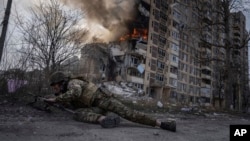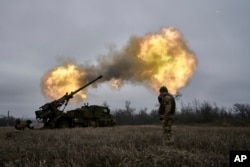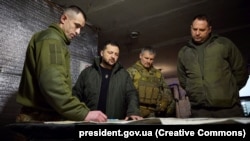In a wooded southeast corner of Avdiyivka, the industrial Donbas city where Ukrainian troops have been desperately holding out against Russian assaults, there’s a facility called Tsar’s Hunt, once frequented by tourists relaxing in its restaurant, a low-slung hotel, gardens, and outdoor pool.
It has served as a heavily fortified base for Ukrainian forces -- the 53rd Mechanized Brigade and 110th Mechanized Brigade, among others, have cycled in and out -- one element of the defenses for the now devastated city, which Russian forces have been trying to encircle since October.
Early last month, Russian sappers and other troops began creeping hundreds of meters underground from the south, moving beneath the facility’s grounds through a partially flooded water outflow tunnel, cutting through metal piping, trying to shroud the noise behind aboveground mortar explosions. Sometime around January 17, an unknown number of Russian troops – 150 by some estimates -- emerged behind Ukrainian lines, sparking a vicious days-long effort by Ukrainian troops to push back the attack.
The surprise, detailed by Russian war bloggers and corroborated by Ukrainian sources, was partially repelled. But in recent days, the reports have gotten more dire, with Russian troops inside the city itself, battling Ukrainian forces block-by-block.
Barring a major tactical blunder by Russia or Ukraine drawing on stretched reserves to reinforce it, Avdiyivka is likely to be captured within weeks, if not days, observers say.
"If we said a few weeks ago that the situation was very difficult but under control,” said Vitaliy Barabash, head of the city’s military administration, said in televised comments on February 6, “now it is very difficult and in some places critical."
“Russian units have entrenched themselves on one of the streets on the northern outskirts,” Yuriy Butusov, a Ukrainian activist and journalist, said in a post to Telegram. “Two weeks ago, the enemy managed to enter two streets on the southern outskirts of the city. The situation is critical.”
Along the 1,200-kilometer front line, Ukraine’s wintry discontent is turning into despondency as Russia forces make slow, grinding advances in Avdiyivka and at least one other location, Kupyansk, in the Kharkiv region further to the north.
With U.S. political infighting stalling a new $60 billion weapons package, and indications that the country’s popular, top military commander could be pushed out, the mood in Ukraine on the eve of the second anniversary of Russia’s all-out invasion is sinking into further gloom.
“The situation is difficult, terrible and in all likelihood, it’s possible that by the end of the month, Avdiyivka will have to be abandoned,” Ivan Stupak, an analyst with the Ukrainian Institute for the Future, a Kyiv think tank, told Current Time. “This is understandable even for people who aren’t involved in war fighting.”
Ukrainians “in general are resigned. I mean [everyone] understand the risks if there is no funding out of the U.S. but do what they can,”, said Mykola Byelyeskov, an analyst at the government-backed National Institute for Strategic Studies: like trying to increase drone production, for example.
“The major open question is ‘what’s next in the second part of the year’ or whether we’ll be able to withstand the next round of a Russian offensive without major U.S. assistance,” he said.
As for Avdiyivka, “if Russia is able to inflict major damage as we try to resupply the town garrison then it’s better to withdraw,” Byelyeskov said. “If not, then it’s better to fight.”
'Stable But Stably Bad And Trending For The Worse'
Fortified by an influx of powerful new Western weaponry -- tanks, armored personnel carriers, self-propelled artillery, infantry fighting vehicles -- Ukraine’s military launched a major counteroffensive last June.
The goal was to punch through Russian lines in several places: south of Orikhiv in the southern Zaporizhzhya region; south of Velyka Novosylka in the Donetsk region further to the east; and in the north, around the obliterated Donetsk region city of Bakhmut.
Those efforts, however, faltered by late last year, thwarted by deep, well-constructed trench lines and anti-tank defenses that inflicted major losses on Ukraine’s NATO-trained brigades. An ambitious, parallel effort to cross the Dnieper River near Kherson in the south and set up a bridgehead there has also stalled out, with Ukrainian soldiers precariously holding on in a small village, unable to break out.
By October, meanwhile, Russian forces fired up their own smaller-scale counteroffensive, pressuring Ukrainian troops in particular in Avdiyivka, which is better known as the home of what was once the country’s largest coke factory. The city’s relative high ground allowed Ukrainian troops to threaten a key highway to the east, and put pressure on the city of Donetsk, whose outskirts are just 10 kilometers to the south.
Russian forces tried to encircle the city, pushing into villages to the northwest and southeast, but were thwarted by Ukraine’s own defenses. Outside experts said Russia suffered major equipment losses, as well as substantial casualties, particularly among units made up of prison inmates, who Russian commanders have employed in staging World War I-style infantry wave attacks.
Ukraine’s defense minister said Russia had lost at least a brigade – around 4,000 soldiers – in the first month of the concentrated effort.
Russian commanders then shifted tactics to brute force assaults from all sides of the city, Barabash, the city’s military administrator, reported in late November.
Ukrainian troops, meanwhile, began reporting serious shortages of ammunition in Avdiyivka and elsewhere; one estimate said Ukraine was firing just 2,000 artillery rounds a day in December, down from 7,000 a year earlier. By contrast, Russian forces were reaching about 10,000 daily.
Then came the January 17 surprise attack via the underground water tunnel. Despite limiting the Russian advance, Ukrainian troops have now reportedly been forced to engage Russian troops in southern and northern districts in block-by-block fighting. Some reports say the west-east road used by Ukraine to resupply defenses and evacuate the wounded is increasingly threatened, and some Russian war bloggers asserted that Ukrainian defenses were falling.
"If the Russian Army takes control of the [supply] road, the Ukrainian armed forces will evidently be forced to withdraw," former Kremlin adviser Sergei Markov said in a Telegram post February 6. “That will be a great victory for the Russian army.
“The situation around of Avdiyivka is, I would say, stable but stably bad and trending for the worse,” Michael Kofman, a defense analyst at the Carnegie Endowment for International Peace, said in a podcast released on January 30. “Since the Russian forces are making incremental gains… I still hold to my earlier judgment back in the fall that there's a good chance Avdiyivka will eventually be lost.”
Legislative Paralysis
The battlefield setbacks dovetail with legislative paralysis in Washington, D.C., which has been the largest single source of weaponry and military equipment for Ukraine since the launch of the invasion in February 2022.
Despite President Joe Biden’s entreaties, Republican lawmakers have refused to authorize a new $60 billion weapons package for Ukraine, tying it to an overhaul of U.S. immigration policy whose prospects for passage are now also deeply clouded. It’s unclear whether lawmakers and the White House will be able to end the standoff, which has also frozen military aid to Israel.
Ukrainian troops, and Ukrainian society more broadly, are also bracing for the expected ouster of the country’s top military commander, General Valeriy Zaluzhniy. In an interview broadcast on February 4 on Italian television, President Volodymyr Zelenskiy signaled that he was considering pushing out Zaluzhniy, who is widely popular, as part of a bigger shakeup of the military and civilian leadership.
Ukrainians by and large continue to support both Zelenskiy’s government and the overall fight against the Russian invasion, according to a poll released in December by the Kyiv International Institute of Sociology. The poll, however, also shows slipping optimism compared with the previous year, when Ukraine managed two successful counteroffensives in the Kharkiv region and in the south, in Kherson.
For his part, Zelenskiy has sought to bolster troops’ morale, making visits to potentially dangerous frontline locations including Avdiyivka in the last week of December, and more recently to Robotyne, a Zaporizhzhya region village where Russian forces have been conducting probing attacks.
“Russia currently holds the strategic initiative,” Mick Ryan, a retired Australian army major general, said in an article published on February 5 by Foreign Affairs. “Unfortunately, defeat [for Ukraine] is still a possible outcome.”



